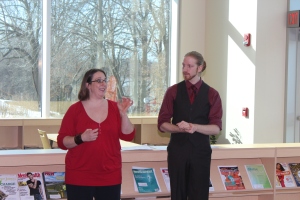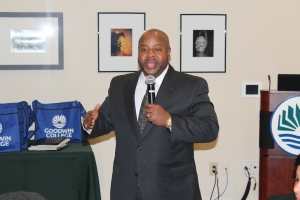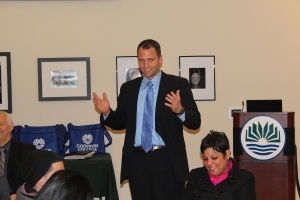Monthly Archives: February 2013
Navs Head to Tourney After Close Hoops Loss
By Eric Emet
Saturday at the “Hangar,” the Navigators scrimmaged American International College’s club travel basketball team, in preparation for the upcoming NIRSA Regional Tournament beginning this Friday, at Boston University. It was a fantastic game, with the score bouncing back and forth, and the Yellow Jackets ultimately winning 72-67. Four of AIC’s points came in the last 9 seconds of the game.
Leading the way for the Navs was Center John Taylor with 23 points and 12 boards, along with Guard Mike Hemingway, who dropped in 20 and cleaned the glass 9 times during the battle. Juan Colon grinded it out in the paint and pulled down 15 rebounds in the loss, spending most of the contest fighting for position against AIC’s starting left guard from their football team, Viondy Merisma (6’4”-305).
With that game in the books, we drew Springfield College in the first round of the Northeast Regional NIRSA tournament this week; Friday night at 10:00 PM. We’ll get some rest, then take on St. John’s University on Saturday morning, at 9 a.m., followed by a game against SUNY-Cortland later in the day at 3 p.m.. Should we muster up a couple of wins, it’s on to the semis on Sunday.
This is a very prestigious tournament; playing are some of the largest basketball factories, er, I mean colleges, from the Northeast. Some of the teams include: Maryland, Boston College, Penn State, Rhode Island, Villanova, Cornell, St. John’s, Brown, Yale and Harvard.
Goodwin Dedicates Classroom to Zuvic, Carr and Associates Engineering Firm
While Goodwin College has dedicated several classrooms and other facilities to community partners, Friday’s dedication to Zuvic, Carr, and Associates had special meaning.
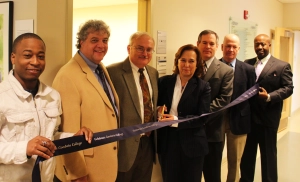
Goodwin College dedicated Room 201 to Zuvic, Carr and Associates on Friday, Feb, 22. Pictured: Goodwin Environmental Studies student Rajiv Atterbury, Goodwin President Mark Scheinburger, ZCA Vice President Tomek Grajewski, ZCA President Marici Zuvic, ZCA Vice President Robert Carr, Goodwin Director of Environmental Studies Program Bruce Morton, and Goodwin Environmental Studies student Desmond Batts.
Over the past eight years, the Rocky Hill-based civil and environmental engineering consulting firm has been instrumental in the cleanup and redevelopment of Riverside Drive and Goodwin’s award-winning River Campus. Through Zuvic Carr’s effort, the former polluted brownfield has been successfully remediated ,redeveloped, and transformed into a gorgeous environment that has become home to one of the fastest growing nonprofit colleges in New England.
Additionally, Zuvic Carr has continually supported the Goodwin College Foundation, which manages the College’s endowment. The firm recently gave the Foundation $25,000 to support the endowment and provide scholarship opportunities to Goodwin students.
The College held a ribbon-cutting ceremony on Friday, Feb. 22 dedicating and naming a classroom at Goodwin in honor of the firm. A plaque now hangs outside Classroom 201 in recognition of the Zuvic Carr gift.
At the dedication ceremony, Goodwin President Mark E. Scheinberg stated his appreciation to the firm, recognizing that while the College has dedicated many classrooms, this particular honor has special significance.
“It’s very nice to do it for someone who is part of the family,” Scheinberg said.
The firm’s dedication to Goodwin College goes beyond its gifts and engineering work. Robert Carr, one of the firm’s owners, has instructed students on environmental science at the Connecticut River Academy, Goodwin’s magnet high school. Additionally, Project Manager Ryan Bartosz has conducted field work with Goodwin Environmental Science students instructing them on how to take field samples and proper measurement techniques.
Zuvic Carr is also a regular sponsor of the annual Goodwin College Foundation Golf Tournament, held every September at the Topstone Golf Course in South Windsor.
“We applaud Goodwin College’s efforts and look forward to continuing our longstanding partnership,” said Marici Zuvic, President of Zuvic, Carr and Associates.
Celebrating Black History through Poetry
Absorbing the passion and power of verse has been at the heart of Goodwin College’s Black History Month Celebration, as evident by two events where poetry provided the medium to understanding the past and future.
The events drew upon work inspired by contemporary and classic poets. The first featured a live slam poet, while the second was a workshop built around the legacy of Langston Hughes, perhaps the most famous poet of the Harlem Renaissance.
On Valentine’s Day, the College welcomed Jasmine Eaton, who goes by the performing name Jazz E, for a Poetry Slam and feature. Jazz E, an accomplished slam poet and spoken word artist, presented some of her work before a packed audience in the Goodwin Student Lounge.
Jazz E performed five poems, including “Dear Hip-Hop,” a piece that is critical of modern trends in popular movement where sexism and violence are idealized over a more positive message. As she spoke, students showed their agreement through applause and rounds of snaps, all while drummer Ernel Grant played beats.
(Note: Clip contains some strong language).
Jazz E is a member of “Poetz Realm” and is a member of the state’s competing slam poetry team. A Bridgeport native, she recited a new poem, “Where are We Going?,” inspired by the Sandy Hook Elementary School shooting, which occurred about 20 minutes from where she lives.
Jazz E’s final poem, which is available to view through the clip, was an “Ode to My Brothers.” The piece blended romantic ideals with respect for individuality and confidence in the Black community and was a fitting for Valentine’s Day.
Eaton is a teacher, and in between poems, she quizzed the audience about Black History and instructed on the nature of slam poetry and spoken word performance.
Students from the Connecticut River Academy joined with Goodwin students on Wednesday, Feb. 20, in another poetry event. Members of the Bridgeport-based Slant of Light Theater Company presented a lesson on Langston Hughes, who rose to fame as a poet during the period known as the Harlem Renaissance.
Hughes is recognized as one of the original jazz poets. His work has inspired generations of writers and he helped draw attention to the injustices faced by Black Americans during the Jazz Age through the Great Depression.
Slant of Light members Nicholas Hattam and Stacy Ruttenberg led the event, which was held in Goodwin’s Hoffman Family Library. Participants studied some of Hughes’ more famous poems, including “The Negro Speaks of Rivers,” as well as some modern slam-style poetry.
Intrepid students put Hughes’ verse to music, taking turns reciting poetry in rhythm with contemporary songs. Some students even took on Robert Frost, reciting the familiar refrain “and miles to go before I sleep” in time with music. The passage comes from “Stopping by Woods on a Snowy Evening,” one of Frost’s most famous poems.
The Emancipation Proclamation: Panel Reflects on Emboldening the Fight Against Slavery
Ask a modern day student what caused the Civil War, and “slavery” is likely the response. However, as guest and faculty panelists explained during a Tuesday event, when the war began, Abraham Lincoln was trying to preserve the Union.
As Christy Coleman, the director of the American Civil War Center in Virginia explained, it took dramatic actions, such as the Emancipation Proclamation, to fortify the Northern cause as a fight not just to put the Nation back together, but to permanently obliterate a terrible institution.
“Slavery was dead, and its death was hastened by this document,” Coleman said.
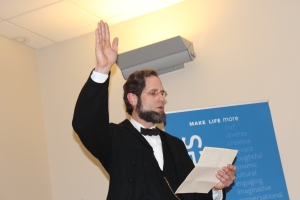
President Abraham Lincoln, as reenacted by Howard Wright, reads his Emancipation Proclamation at Goodwin College.
On Tuesday, Goodwin College, the Harriet Beecher Stowe Center, and Connecticut Humanities hosted a retrospective panel on the 150th anniversary of Lincoln’s Emancipation Proclamation, a document with significance that has been challenged in recent years.
In addition to speakers from Goodwin and the Stowe Center, the event featured a performance by a recognized Lincoln portrayer, Howard Wright, who stayed in character throughout the evening is his portrayal of the 16th President and American hero.
Coleman, the event’s keynote speaker, explained to the audience that in recent history, the Proclamation has gotten a “bad rap” and its significance has been taken for granted. No, the document did not free all slaves, nor did it make the practice of slavery illegal.
It did, however, embolden the Union’s cause that all slaves in the Confederate states would be free, and strengthened the Northern army by escaped slaves who enlisted to join the cause. In essence, Coleman said, the Civil War became a fight over slavery, and the North had a cause worth pursuing.
Coleman discussed at-length the atmosphere that led to Emancipation Proclamation. In 1862, the Union and Confederate forces had suffered hundreds of thousands of casualties. Lincoln was at ends with his military leadership, particularly General George McClellan, who had strong and even personal ties to officers commanding the Confederate forces.
Escaped slaves fleeing from the South were joining the Union army in great numbers, made possible through the Confiscation Act. This was a growing problem for the South, as slaves were an integral part of preparing cities for defense and providing manual labor to benefit the war effort.
The Battle of Antietam, the bloodiest single-day battle of the entire Civil War, was fought on Sept. 17 in Maryland. The result of the battles was fairly inconclusive, but Lincoln was encouraged by the Union’s fortitude. The president decided the time was ripe for bold action, and on Sept. 22, he would issue the preliminary Emancipation Proclamation, setting a timeline of 100 days for it to take effect on Jan. 1, 1863.
In between the preliminary announcement and implementation date, Coleman explained, the United States was in an extremely tense situation. Foreign powers had yet to recognize any difference between the North and South and negotiations were underway for the South to begin trading with Europe.
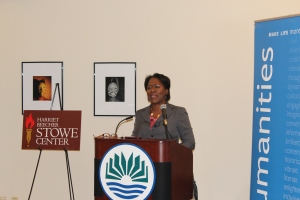
Christy Coleman, President of the American Civil War Center in Richmond, speaks on the legacy and significance of the Emancipation Proclamation.
The Emancipation Proclamation became a turning point for the rest of the world to side with the North and recognize the Civil War as a just cause to end slavery. During the 100 days between Lincoln’s initial push and implementation, Europe was held at bay from developing trade with the South, despite the rich cotton industry that lay in the balance.
“For 100 days, the eyes of the world were on this country,” Coleman said.
Earlier during the event, Wright read parts of the Proclamation and provided Lincoln’s perspective on its importance. He quoted what Lincoln is purported to have stated at the signing of the Proclamation, declaring “If I go down in history it is for this act and my whole soul is in it.”
Looking the part perfectly, Wright, as Lincoln, explained that there was great uncertainty over what should happen to freed slaves. Many, like Lincoln, believed racial equality was impossible, and the best course of action would be for freed men and women to colonize in the Caribbean or South America.
But, as Coleman detailed, the prevailing black scholars of the time refused any such overtures from Lincoln. Frederick Douglass, a good friend to the president and a frequent adviser, was among those who felt that the United States had been built largely by black men and women, and they would not be expelled from a nation they were so vital in developing. Eventually, Lincoln acquiesced.
The 13th, 14th, and 15th Constitutional Amendments abolished slavery, took measures to ensure rights for freed slaves, and gave all men the right to vote, regardless of race or color. Coleman said that Lincoln’s push for black suffrage was ultimately what motivated John Wilkes Booth to assassinate the president.
Following Coleman and Wright, panelists discussed the legacy of the Emancipation Proclamation, including its significance today.
Dr. Randy Laist, a Goodwin College English professor, noted that Lincoln is quite in vogue at the moment. Laist discussed the Stephen Spielberg film about the president currently a favorite to win an Oscar for Best Picture, as well as some more farcical interpretations of Lincoln that have him battling vampires and zombies.
Laist said there was something about Lincoln that personifies American idealism of strength, morality, and cause, with the Emancipation Proclamation as a significant tipping point in the Lincoln legacy.
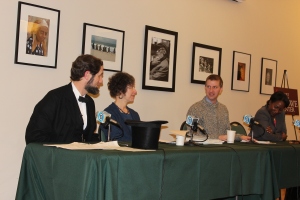
Goodwin English Professor Randy Laist, right, discusses the recent Lincoln pop culture phenomenon, drawing the interest of the 16th President. Katherine Kane, Executive Director of the Stowe Center,also participated in the Tuesday night panel.
“The Emancipation Proclamation is the tipping point, from Thomas Jefferson to Barack Obama,” Laist said.
Katherine Kane, executive director of the Stowe Center, discussed Stowe’s legacy as helping to lay the seeds for the Civil War and the Emancipation Proclamation. Harriet Beecher Stowe, a neighbor of Mark Twain in Hartford, stirred emotional responses to human bondage when she published Uncle Tom’s Cabin in 1852.
Kane said that even today, Americans are inspired to think about the issues on which the nation was founded, and how historical figures like Lincoln and Stowe continue to steer the conversation.
“We now know how much further we have to go, and we’re working together to do it,” Kane said.
Goodwin Mentors to Help Youth Go “Above and Beyond”
As mentors and inspiring stories go, there’s no one quite like James Tillman who can ignite a positive spark.
Tillman, who spent 18 ½ years in prison after a false criminal conviction, shared his tale of overcoming adversity on Tuesday, speaking at Goodwin College before an audience of 25 high school students, their parents, and a team of community partners eager to make a difference.
“These people came together, like they did for me, because they believe in you guys and what you can do,” Tillman told the students.
Goodwin College is one of several community organizations that have partnered in “Above in Beyond Career Explorers.” The brand new program seeks to provide mentorship, training, and guidance to 25 students from the Synergy Alternative High School in East Hartford. The Explorers celebrated the start of the program with a dinner and ceremony held in the Goodwin Community Room.
The three-year program aims to teach the students important skills that will help them socially, academically, and professionally. The Town of East Hartford is coordinating the program, which was conceived by East Hartford High School Guidance Coordinator Frank Staples.
Synergy Principal John Karzar said he did not consider the students to be “at-risk,” but “at-promise” to become leaders and productive members of the workforce.
East Hartford Superintendent of Schools Nathan Quesnel told the students that they need two types of vision: what they have today and what they can do tomorrow. Today, they can learn the skills that will lead to the successful people they can become tomorrow.
“Where are we going? What is the end game for you?” Quesnel asked the students.
Partners include Goodwin, the Board of Education, Connecticut Center for Advanced Technology, Capital Workforce Partners, the East Hartford Chamber of Commerce, Pratt & Whitney, and Work Keys.
Goodwin’s contributions include a venue for events like Tuesday’s opening gala and mentorship. The College has committed members of the MOVE and WISE program to serve as mentors to Synergy students. The Explorers may also attend meetings of MOVE and WISE and participate in career workshops.
Tillman, who described himself as a “51-year-old college student,” is enrolled at Goodwin and is a mentor to the MOVE program. In the late 1980s, he was sentenced to 45 years in jail for a crime he did not commit, and after serving 18 ½ years of his sentence, new evidence exonerated Tillman and he was released from prison.
Prior to incarceration, Tillman told the students he had squandered many opportunities to get educated and trained to enter the workforce and encouraged the Explorers to not make the same mistakes.
While in prison, Tillman found a renewed faith In Christianity and became a source of inspiration to fellow inmates. He let go of his anger and bitterness of his situation and found ways to be a productive member of society.
“Even though I had 45 years, I said I am going to make something of myself,” Tillman said.
When Tillman was released, Goodwin extended an opportunity for an education and he is now pursuing a degree in Human Services. He enjoys being a student and relishes the opportunity to wear a suit and tie instead of the brown khaki jumpsuit he was forced to wear for almost two decades.
“I can do whatever I want today, and it’s a good feeling,” Tillman said.
What’s Next at the River Campus: Big Construction Projects Sprint Ahead
Four major brand new construction projects underway on the Goodwin campus are moving quickly ahead, promising the continued transformation of the riverfront and nearby neighborhood, as well as the extension of Goodwin’s educational mission to hundreds more students, from prekindergarten age all the way to College.
In the first week of the 2013, we jumped in a Goodwin College van with facilities guru Dan Larson for a jaunt around Goodwin’s various work sites, gaining a sneak preview of the big, exciting new developments in store this year.
The Connecticut River Academy
103,000 square feet
Opening: 2013-14 Academic Year

One of the main window walls is already installed and the parking garage is completed at the Connecticut River Academy.
Visitors to Goodwin’s River Campus may have seen lines of giant flatbeds rumbling off the Route 2 exit, hauling hundred-ton concrete slabs. Giant cranes then lift the slabs to form the skeleton of a towering four-story parking garage.
Everything about the new Connecticut River Academy building is big and impressive, and its riverfront venue promises one of the most striking waterfront school campuses in Connecticut.
When students move to the brand new building early next year, there will be no shortage of spectacular views, both inside and outside the building. High ceilings with a series of huge, circular windows line the main area of the school, where construction has been ongoing even while much of the rest of Goodwin was on vacation.
The school is under construction on Riverside Drive at the intersection with Colt Street. Once completed, the Academy will be the second biggest building on campus behind only the main academics building.
The state-of-the-art school building will feature a full gymnasium, exercise facility, considerable cafeteria space, and a “green roof.” Students and teachers will have incredible views of the Connecticut River through large panel windows that line the Academy’s exterior — a fitting tie-in with the school’s environmental focus.
Most of the proverbial bells and whistles won’t be completed until later. Still, a walk through the building revealed dynamic and welcoming spaces for learning and gathering for the 480 students that will be enrolled at the Academy.
Goodwin students will have some access to the gymnasium and fitness facilities when the building is complete, according to planners.
The Colt Street Cottage
Opening: Spring 2013
Perhaps with a dash of Goodwin humor, the riverfront structure at the end of Colt Street has been nicknamed the “President’s Cottage.” In reality, it’s hardly a cottage, rather taking the appearance of an elegant timeshare situated on campus.
The only residential property in East Hartford with direct access to the Connecticut River, the Cottage is projected to serve as a reception space for the college and temporary lodging for college guests. The Cottage has the appearance of a three story, Victorian-style bungalow and is built along risers to ensure its elevation above the river’s floodplain. Each floor has a different purpose, as well as access to balconies that open onto the water and the Hartford skyline.
The first floor is designated as reception space for gathering, complete with a kitchenette and a fireplace. The second floor has two bedrooms for visiting dignitaries to the College, as well as an adjoining bathroom. The third floor is an apartment all its own, with a kitchen, master bedroom, living area, and other facilities.
Pathways Academy of Technology and Design
80,000 square feet
Opening: 2013-14 Academic Year
In a few months, much work has already been completed the new Pathways Academy of Technology and Design. That’s a good thing, considering the hundreds of students waiting for their new school to be up and running.
The Academy, which is renamed from the former Pathways to Technology Magnet School in Windsor, is a little different than other Goodwin magnet projects. The school will be run by the Hartford Board of Education.
After breaking ground in September, the foundation has already been laid and steel is up on site, located on Pent Road, just offsite from the main campus, at the entrance to the former Wilgoos property.
Early Childhood Magnet School
34,000 Square Feet
Opening: Summer 2013
The Goodwin College Early Childhood Magnet School is perhaps one of the most intriguing designs of any of the buildings being constructed. Drawing on the Reggio Emilio Approach, the school will feature several wings that open onto a center courtyard.
The school will be one story high, and the design is important to type of instruction and learning that will take place within the classrooms and the courtyard. The concept allows for the learning environment to play a crucial role in developing a child’s creativity and their comfort in the world that surrounds them.
The school is being built on Willowbrook Road in East Hartford, a very short distance from the River Campus on the site of Willowbrook School, a facility that houses East Hartford’s Head Start program for prekindergarten. Upon completion, the new school will be open to children ages 3 to 5 in prekindergarten and kindergarten programs. In all, 240 students will attend the school, which will draw pupils from local communities.
247 Riverside Drive
Taking the place of a derelict brick garage razed in 2012, a two story building has been built to accommodate the college’s rapid growth.
Inside, you’ll find the headquarters for Business Administration, Organizational Studies, and the College’s Communications department.
The facility provides some much-needed classroom and lab space on the first floor, with all Occupational Therapy Assisting classes to be held there. The second floor is reserved for office space. The Business Administration and Organizational Studies programs have moved into Room 201. Goodwin’s Communications and Marketing team has moved into Room 202.
The building has unofficially been nicknamed “24/7 Riverside” to highlight the tireless and dynamic work that happens within its confines.
403 Main Street
Expansion: 10,586 square feet
Total size: 28,632 square feet
Work will be ongoing at 403 Main St. throughout the semester. The College is preparing to increase the size of the building, which formerly housed the Advancement Department as well as the programs temporarily moved down the street. The building may become the future home of a Dental Hygiene Program, which is in early development.
Several programs have been moved for the Spring Session to accommodate a renovation project at 403 Main St. Histology lab courses will be held at 2 King Court, as well as offices for the Histology and Occupational Therapy Assisting Programs. All courses and offices for the Medical Assisting, Medical Billing and Coding, and Phlebotomy Programs have moved to 1137 Main St.
The Advancement and Facilities Departments have also moved within the last six months. They are now at 349 and 351 Main St., next to the Goodwin College Community Garden.
